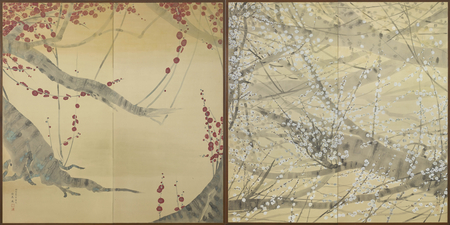Product Description
7351/52 A pair of two-fold paper screens painted in ink and colour on a buff ground with red and white ume (plum)
Signed: Shōwa yon jyū rokunen shingai. Tsusima Susumu (Shōwa 46* of the sexagenary cycle)
Seals: illegible, Susumu
Japan 20th century Shōwa period 1971*
Dimensions: H. 67¾” x W. 67¾” (172cm x 172cm)
Tsushima Susumu (1923-2012) was born in Tokyo and in 1941 began studying painting under the Nihonga (Janapanese style) painter Gōkura Senjin (1892-1975). In 1955 he joined Inten as a member.
In 1959 he left the workshop of his teacher Gōkura and ceased to exhibit at the Inten. Ten years later, in 1969 he had his first solo exhibition at Miyuki gallery followed by another one in 1970. During this period he held a solo show annually and in 1977 he had a show at the famous Shiseido gallery in Ginza Tokyo and also participated in the Yamatane museum Award Exhibition. This association continued for some years with one more show at Shiseido gallery and two more at the Yamatane museum and he also held several exhibitions of his work at Chigasaki Prefecture.
In Japan plum blossoms are celebrated as a harbinger of spring due to it blooming towards the end of January. The blooms appear when there is still snow on the ground, and it is considered a symbol of strength and overcoming adversity. It has also been known as one of the shōchikubai (lit. pine-bamboo-plum or saikansanyū lit. three friends of winter) since the beginning of the 13th century. The plum also symbolises longevity as the blossoms continue to appear on old gnarled branches of ancient plum trees, their sweet fragrance improving with age.
Paintings of blossoming plum offer artists excellent opportunities to demonstrate the calligraphic flair of their brushwork. Since plum blossoms have multiple connotations in Chinese and Japanese cultures their representation offers numerous possibilities of symbolic expression. As one of the earliest spring-flowering trees, plum symbolizes rejuvenation and vitality. Because the tree is hardy and often long lived, its branches also signify endurance and perseverance. In other contexts, the delicate white blossoms were often associated with purity and feminine gracefulness. With so many possible meanings, paintings of plum blossom could be displayed on many occasions, a versatility that was no doubt part of the genre’s long-lasting appeal.
It would seem likely that the pairing of red and white as seen in this iconic imagery has its roots in the Gempei war between the Taira and Minamoto clans at the end of the 12th century, with the victorious Minamoto founding the Kamakura period (1185-1333). This war and its aftermath established red and white, the respective colours of the Taira and Minamoto, as Japan’s national colours. Today, this combination of colours can be seen in sumo competitions, various traditional activities and on the national flag of Japan.












